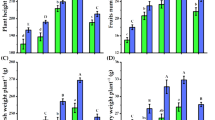Abstract
Both the neutral and acidic fractions of the acetone extract of yellow fieldcress (Kireha-inugarashi,Rorippa sylvestris Besser) inhibited lettuce seed germination. Salicylic,p-hydroxybenzoic, vanillic, and syringic acid were identified in the acidic fraction. In the neutral fraction, hirsutin (8-methylsulfinyloctyl isothiocyanate), 4-methoxyindole-3-acetonitrile, and pyrocatechol were identified. Bioassay using a root exudate recirculating system showedR. sylvestris during flowering inhibited the lettuce seedling growth. Hirsutin (13μg/plant/day) and pyrocatechol (9.3μg/plant/day) were the major compounds released into the rhizosphere. Several combinations of pyrocatechol,p-hydroxybenzoic acid, vanillic acid, and hirsutin reduced lettuce seedling growth. These compounds seemed to be allelochemicals.
Similar content being viewed by others
References
Einhellig, F.A. 1986. Mechanisms and modes of action of allelochemicals, pp. 171–188,in A.R. Putnum and C.S. Tang (eds.). The Science of Allelopathy, John Wiley & Sons, New York.
Einhellig, F.A. 1987. Interactions among allelochemicals and other stress factors of the plant environment, pp. 343–357,in G.R. Waller (ed.). Allelochemicals: Role in Agriculture and Forestry. American Chemical Society, Washington, D.C.
Harborne, J.B. 1988. Introduction to Ecological Biochemistry, 3rd ed. Academic Press, London, pp. 312–315.
Kawabata, J., Fukushi, Y., Hayashi, R., Suzuki, K., Mishima, Y., Yamane, A., andMizutani, J. 1989. 8-Methylsulfinyloctyl isothiocyanate as an allelochemical candidate fromRorippa sylvestris Besser.Agric. Biol. Chem. 53:3361–3362.
Kutters, A.T. 1989. Effects of phenolic acid on germination and early growth of herbaceous woodland plants.J. Chem. Ecol. 15:467–479.
Manners, G.D., andGalitz, D.S. 1985. Allelopathy of small everlasting (Antennaria microphylla): Identification of constituents phytotoxic to leafy spurge (Euphorbia esula).Weed Sci. 34:8–12.
Mizutani, J., andYamane, A. 1991. Chemodynamics of glucosinolates in Kireha-inugarashi, Rorippa sylvestris.Weed Res. (Japan) 36:68–73.
Morita, H. 1981. Characteristics of naturalized weeds and some problems of their control in Hokkaido, 5th Symposium of the Weed Science Society of Japan, Sapporo.
Nomoto, M., andTamura, S. 1970. Isolation and identification of indole derivatives in clubroots of Chinese cabbage.Agric. Biol. Chem. 34:1590–1592.
Olsen, O., andSørensen, H. 1981. Recent advances in the analysis of glucosinolates.J. Am. Oil Chem. Soc. 58:857–865.
Schulz, J.M., andHerrmann, K. 1980. Analysis of hydroxybenzoic and hydroxycinnamic acids in plant material, II. Determination by gas-liquid chromatography.J. Chromatogr. 195:95–104.
Stevens, G.A., Jr., andTang, C.-S. 1985. Inhibition of seedling growth of crop species by recirculating root exudates ofBidens pilosa L.J. Chem. Ecol. 11:1411–1425.
Tadano, T., andTanaka, A. 1976. Differences for crop species of ammonium and nitrogen suitability.Nippon Dojo-Hiryogaku Zassi 47:321–328.
Tang, C.-S., andTakenaka, T. 1983. Quantitation of a bioactive metabolite in undisturbed rhizosphere—benzyl isothiocyanate fromCarica papaya L.J. Chem. Ecol. 9:1247–1253.
Wetter, L.R., andYoung, C.G. 1976. A thiourea-UV assay for total glucosinolate content in rapeseed meals.J. Am. Oil Chem. Soc. 53:162–164.
Williams, R.D., andHoagland, R.E. 1982. The effects of naturally occurring phenolic compounds on seed germination.Weed Sci. 30:206–212.
Author information
Authors and Affiliations
Rights and permissions
About this article
Cite this article
Yamane, A., Nishimura, H. & Mizutani, J. Allelopathy of yellow fieldcress (Rorippa sylvestris): Identification and characterization of phytotoxic constituents. J Chem Ecol 18, 683–691 (1992). https://doi.org/10.1007/BF00994606
Received:
Accepted:
Issue Date:
DOI: https://doi.org/10.1007/BF00994606




